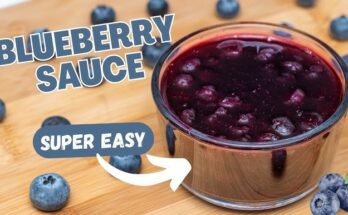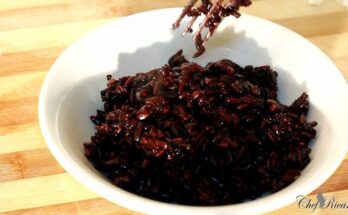Vegetable Broth Recipe: There’s something magical about a warm, rich broth simmering on the stove. Whether you’re whipping up a cozy soup, cooking grains, or adding depth to a sauce, vegetable broth is a pantry staple every home cook should master. The best part? You don’t need to buy it in a box—you can make it yourself with scraps you might have otherwise thrown away.
What is Vegetable Broth?
Vegetable broth is a flavorful liquid made by simmering a mix of vegetables, herbs, and spices in water. It serves as a base for countless recipes—from hearty soups and risottos to stews and even some sauces. Unlike stock, which often contains bones, broth is typically lighter and completely plant-based. It’s a go-to for vegetarians, vegans, or anyone looking to cut down on processed foods without sacrificing taste.
It’s not just hot water with vegetables floating in it. A good vegetable broth extracts deep flavors from a balanced mix of ingredients, creating a savory, rich base that elevates any dish. You can make it fresh with purpose-bought veggies or repurpose scraps from your week’s cooking, which makes it both versatile and economical.
Why Make Your Own?
While store-bought broths are convenient, they often come loaded with sodium, preservatives, and sometimes even artificial flavors. When you make your own, you control everything that goes in. Want it low-sodium? Done. Prefer a punch of garlic or ginger? Add more. It’s your broth, your rules.
Besides control, it’s also about taste. Homemade broth is always fresher, richer, and more nuanced than anything poured from a box or can. Once you start making your own, it’s hard to go back to the store-bought stuff.
Benefits of Homemade Vegetable Broth
Health Benefits
Homemade vegetable broth isn’t just tasty—it’s good for you, too. Here’s how:
- Low in Calories: Most vegetable broth is low in calories, making it a great choice for light meals or detox diets.
- Rich in Nutrients: When you simmer vegetables slowly, their nutrients—like vitamins A, C, and K, as well as antioxidants—infuse into the liquid.
- No Preservatives: Unlike store-bought versions, homemade broth contains no artificial preservatives, flavor enhancers, or added sugar.
- Supports Digestion: Warm broths are gentle on the stomach and can aid digestion, especially when seasoned with herbs like ginger and turmeric.
Cost-Effective and Eco-Friendly
Tossing out vegetable peels and ends? Not anymore. Homemade broth gives new life to food scraps, helping you reduce kitchen waste. Think of it as free flavor—why pay for broth when you’re already throwing away the ingredients?
Plus, broth-making is a great way to stretch your grocery budget. Instead of buying fresh ingredients just for flavoring liquid, you can build a rich broth from onion skins, carrot peels, celery leaves, and herb stems. You’re not only saving money—you’re helping the planet.
Essential Ingredients for Vegetable Broth
Core Vegetables
Not all vegetables belong in broth. Here’s what you should start with:
- Onions: The backbone of flavor. You can use skins, ends, or whole onions.
- Carrots: Add natural sweetness and richness.
- Celery: Brings earthiness and rounds out the flavor trio.
This trio—onions, carrots, and celery—is often called the mirepoix. It’s the holy trinity of broth-making and forms the foundation of countless recipes.
Herbs and Spices
Here’s where your broth starts to sing:
- Garlic: A must-have for savory depth.
- Bay Leaves: Adds a subtle, herbal complexity.
- Thyme & Parsley: Bright and earthy.
- Black Peppercorns: For that gentle heat and spice.
Avoid using salt while making the broth—you can always season later. Keeping it unsalted gives you flexibility depending on the dish you’re cooking.
Optional Add-Ins for Flavor Boost
Want to customize your broth further? Here are great add-ins:
- Mushrooms: Especially shiitake or cremini, they add umami richness.
- Tomato Paste: A tablespoon deepens the flavor.
- Ginger or Turmeric: Great for an immune-boosting broth with a kick.
- Corn Cobs: Add sweetness and a lovely body to the liquid.
Just be cautious with strong or bitter vegetables like broccoli, cauliflower, or Brussels sprouts—they can overpower the broth if not balanced correctly.
Tools You’ll Need in the Kitchen
Must-Have Equipment
You don’t need a fancy setup to make broth, but a few basics will help:
- Large Stockpot: A sturdy 6- to 8-quart pot works well.
- Strainer or Cheesecloth: For clean, clear broth.
- Ladle: Makes it easier to transfer hot liquid safely.
- Storage Containers: Mason jars, freezer-safe containers, or ice cube trays work great.
Handy Accessories
If you’re serious about broth-making, these can make life easier:
- Compost Bin: For scraps you don’t use.
- Labeling Stickers: Helps keep track of broth types and dates.
- Slow Cooker or Instant Pot: Set it and forget it—ideal for busy days.
Keeping a scrap bag in the freezer is a game-changer. Every time you chop veggies, just toss the clean scraps into a freezer-safe bag. Once it’s full, it’s broth time!
Step-by-Step Guide to Making Vegetable Broth
Step 1 – Wash and Chop Your Vegetables
First, give everything a good rinse. Dirt, pesticides, or grit can make your broth bitter or muddy. You don’t need to peel or perfectly chop your veggies—just aim for uniform pieces to ensure even cooking. Use about 4-5 cups of mixed vegetables for every 8 cups of water.
Step 2 – Sauté Aromatics for Depth
Want your broth to have that restaurant-quality flavor? Don’t skip the sauté step. While it’s totally optional, taking a few extra minutes to sauté your aromatics before adding water can make a world of difference in taste.
Start with a tablespoon or two of olive oil in your stockpot over medium heat. Add chopped onions, garlic, carrots, and celery. Let them cook for 5–7 minutes, stirring occasionally, until the vegetables begin to soften and the onions become translucent. This simple action triggers caramelization, which adds a rich, savory base to your broth. If you’re using tomato paste or mushrooms, add them at this stage too. They will deepen the broth’s umami notes and complexity.
Herbs like thyme, rosemary, or bay leaves can also go in during this step to help release their essential oils. The sautéing process creates layers of flavor, giving your broth more character than just boiling vegetables in water.
If you want to kick up the health benefits or add a unique twist, throw in some turmeric or ginger here. These ingredients not only add flavor but are known for their anti-inflammatory and immune-boosting properties.
You’re not looking to brown the vegetables aggressively—just a light golden edge will do. This gentle browning enhances the broth’s overall body and makes it feel like something slow-simmered all day—even if you whip it up in under an hour.
Step 3 – Simmer and Steep
Once your aromatics are nice and fragrant, it’s time to add water. Pour in about 8 cups of filtered water (more or less depending on your pot size and how concentrated you want the broth). Give everything a good stir, making sure to scrape up any bits stuck to the bottom of the pot—those are flavor gold.
Turn the heat up to high and bring the mixture to a boil. Once boiling, reduce to a simmer. This is where the magic happens. Cover the pot loosely and let it simmer for at least 45 minutes to an hour. If you have more time, let it go for up to 2 hours for a deeper, more intense flavor.
Keep an eye on it and occasionally stir. You can also taste-test along the way to see how it’s developing. Remember, since you’re not adding salt, you’re relying on the natural richness of your veggies and herbs.
During this step, your kitchen will smell absolutely divine. It’s comfort in scent form. Simmering coaxes every bit of goodness out of the vegetables, creating a broth that’s not just flavorful but nourishing.
If you’re using a slow cooker, set it on low for 6–8 hours. An Instant Pot can get you rich broth in about 30–40 minutes under pressure.
Step 4 – Strain and Store
Once your broth has simmered to perfection, it’s time to strain. Carefully ladle or pour the mixture through a fine-mesh strainer or cheesecloth into a large bowl or another pot. Press down on the solids to extract every last drop of flavor, then discard (or compost) the mushy vegetables.
Now, let your broth cool. Don’t rush this—pouring hot broth into storage containers can be dangerous and may warp plastic. Once it’s room temperature, transfer your broth into jars or containers. For longer shelf life, freeze portions in freezer-safe jars, silicone trays, or even ziplock bags laid flat (a huge space-saver).
Storage Tips:
- Refrigerator: Keeps for about 5–7 days.
- Freezer: Lasts up to 3 months.
- Ice Cube Trays: Great for quick use in sauces or sautéing veggies.
Label everything with the date so you know when it’s time to use it. You’ll be glad to have it on hand for those nights when a quick soup or pasta dish needs a little extra something.
Creative Ways to Use Your Vegetable Broth
Cooking Grains and Pasta
Why use plain water when you can infuse grains with flavor? Boil your rice, quinoa, or couscous in vegetable broth instead of water. It instantly upgrades your side dishes, giving them a savory depth that pairs perfectly with roasted veggies or grilled proteins.
The same goes for pasta. Cooking it in broth (or at least finishing it in a ladle of hot broth) helps bind flavors in pasta salads and soups. It’s a simple switch that brings out complex taste with zero extra effort.
Soups and Stews
This is the most obvious, but also the most satisfying use for your homemade broth. From classic vegetable soup to creamy potato leek or lentil stew, your broth sets the tone for the entire dish. A rich, well-balanced broth makes a soup hearty and fulfilling, even if the ingredients are minimal.
Because it’s unsalted, you can tailor each soup’s seasoning to your preference. Add noodles, beans, greens—whatever you like. Think of broth as your soup’s canvas, waiting for your creative touch.
Sauces and Gravies
Out of chicken stock? No problem. Use your homemade veggie broth in sauces, gravies, or even to deglaze a pan after roasting vegetables or sautéing onions and garlic. It enhances sauces like a charm, giving them a savory backbone without relying on heavy cream or meat-based stocks.
Deglazing with broth adds extra flavor to stir-fries, risottos, and pan sauces for everything from tofu to mushrooms.
Customizing Your Vegetable Broth
Flavor Variations by Cuisine
- Asian-Inspired: Add ginger, garlic, scallions, soy sauce, and a piece of kombu for a miso-soup-like base.
- Mexican-Inspired: Try adding dried chilies, coriander seeds, and a touch of cumin.
- Italian-Inspired: Toss in rosemary, thyme, basil stems, and a small piece of tomato.
A few tweaks can completely transform the profile of your broth. Try creating small batches in different styles and labeling them for quick recipe-specific use.
Using Vegetable Scraps
Don’t toss those onion skins, carrot tops, or celery leaves. Store them in a freezer-safe bag and keep adding scraps throughout the week. When it’s full, it’s time to make broth.
Scrap ideas that work well:
- Onion and garlic skins
- Carrot peels
- Celery tops and leaves
- Herb stems
- Leek greens
Just make sure they’re clean and not moldy or too wilted. This technique reduces waste and saves money while still delivering amazing flavor.
Common Mistakes to Avoid
Overpowering Ingredients
Not every vegetable is broth-friendly. Stay away from strong or bitter vegetables like:
- Broccoli
- Cauliflower
- Brussels sprouts
- Artichokes
They can add a funky, sulfur-like flavor that takes over your entire broth. Same with too many potato peels—they can cloud the broth and make it starchy.
Skipping the Simmer
Impatience is the enemy of good broth. Don’t rush the simmering process. The longer it steeps, the more depth and complexity your broth will develop. A quick boil might pull out some flavor, but it won’t have that cozy, homemade richness.
Salting Too Early
It might be tempting to salt your broth as you go, but resist. You want your broth to be a flexible base for any dish. Add salt later—when you’re actually cooking with it. That way, you won’t over-season and ruin the balance of your final dish.
Storing and Freezing Tips
Best Containers to Use
Glass mason jars are perfect for fridge storage—just don’t forget to leave some room at the top if freezing (broth expands when it freezes). Silicone molds or ice cube trays are great for smaller servings, and they let you pop out just what you need.
Label everything! Trust us, a month from now you won’t remember which container is veggie broth and which one is leftover pasta sauce.
How Long Does It Last?
- Fridge: 5 to 7 days
- Freezer: 3 to 4 months
To avoid freezer burn, make sure containers are airtight and don’t stay open too long during portioning.
FAQs about Vegetable Broth Recipe
1. Can I freeze vegetable broth?
Absolutely! Vegetable broth freezes beautifully. Just let it cool completely, pour it into airtight containers or freezer bags, and store it for up to 3 months. Ice cube trays work great for small portions!
2. How long does homemade vegetable broth last in the fridge?
When stored properly in a sealed container, it lasts up to 5–7 days in the refrigerator. If it smells funky or looks cloudy, it’s time to toss it.
3. What vegetables should I avoid in broth?
Skip starchy or overpowering veggies like potatoes, beets, and cabbage. They can make the broth cloudy or give it a funky flavor.
4. Can I use veggie scraps instead of whole vegetables?
Yes! Onion peels, carrot ends, and celery tops make excellent broth. Just avoid bitter scraps like broccoli stalks or Brussels sprouts.
5. Is vegetable broth the same as vegetable stock?
They’re often used interchangeably, but technically, broth is seasoned and ready to eat, while stock is usually unseasoned and used as a base.
6. How do I make broth richer in flavor?
Roast your vegetables before simmering, or add umami boosters like tomato paste, mushrooms, or a splash of soy sauce.
7. Can I use vegetable broth instead of chicken broth?
Yes, vegetable broth is a great vegetarian substitute for chicken broth in soups, risottos, and sauces. Just note the flavor will be lighter.
Conclusion
Making your own vegetable broth might sound like a small step—but it’s a powerful one. It gives you better flavor, better nutrition, and a chance to reduce food waste all at once. Plus, it’s easier than most people think. With just a few scraps and a little simmering time, you can transform your cooking from bland to brilliant.
So next time you’re chopping vegetables, don’t throw those scraps away—throw them in a pot instead. You’ll be surprised at how much flavor (and joy) you can extract from what used to be trash.



